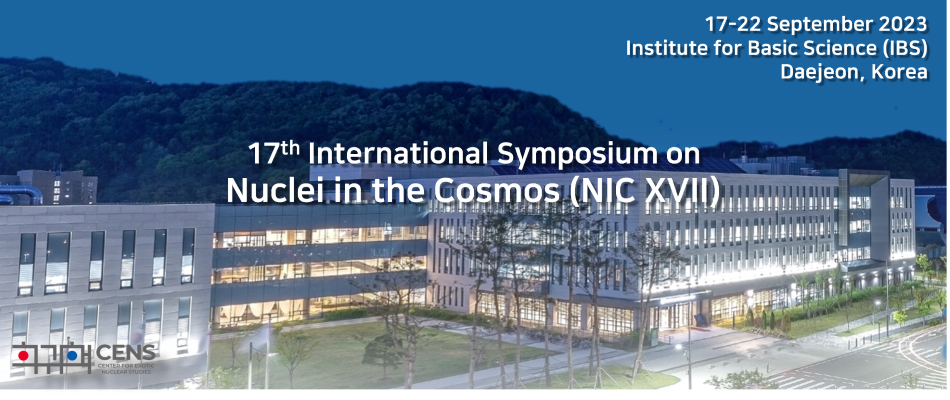PANDORA (Plasmas for Astrophysics, Nuclear Decay Observations and Radiation for Archaeometry) is an upcoming facility at INFN - LNS aiming to use an electron cyclotron resonance ion source (ECRIS) as a compact magnetoplasma to measure in-plasma $\beta$-decay lifetimes of radioisotopes. Decay rates are susceptible to changes in atomic configuration of the parent and daughter systems and are...
Theoretical predictions and past experiments on highly ionized atoms have shown that the β-decay lifetime can be modified even by several order of magnitudes relative to the value observed in neutral atoms due to the opening of a new decay channel called bound-state β-decay [1,2]. The effect of this variation is particularly relevant for those nuclei placed at the branching point of the...
We have studied the structure of the proton-rich 14O nucleus by performing the 10C + α elastic scattering measurement at the CRIB facility (CNS, the university of Tokyo). Recently, the cluster nature for some resonances was identified in the mirror nucleus 14C via the 10Be + α reaction (1). A preliminary Resonating Group Method (RGM) calculation has suggested that also the 10C + α system may...
The Rare isotope Accelerator complex for ON-line experiments (RAON) is a heavy ion accelerator facility that provides both stable and rare isotope (RI) beams for basic and applied science research. The in-flight fragment (IF) separator of RAON, the main device for producing RI beams, is under development. In order to efficiently produce RI beams by using in-flight fission of uranium beams as...
The $^{12}$C+$^{12}$C fusion reaction plays an important role in various astrophysical models, such as type Ia supernova, superburst, and the evolution of massive star. The direct measurements are limited by backgrounds at energies above E$_{\rm c.m.}$=2.1 MeV. To overcome this limitation, we have developed a novel technique to study the $^{12}$C($^{12}$C,$\alpha$)$^{20}$Ne reaction by using a...
A multi-purpose experimental instrument, called KoBRA (Korea Broad acceptance Recoil spectrometer and Apparatus), was constructed at the Institute for Rare Isotope Science (IRIS), as a part of the RAON facility in Korea. Stable or rare isotope (RI) beams can be produced using Electron Cyclotron Resonance (ECR) ion sources or the Isotope Separation On-Line (ISOL) system at RAON, and these beams...
Nuclear Data Production System (NDPS) is one of the experimental systems at the Rare isotope Accelerator complex for ON-line experiments (RAON). It provides high-energy neutrons up to tens of MeV. The primary objective of NDPS is to accurately measure the neutron-induced nuclear cross sections, particularly for the neutron energy extending up to tens of MeV region. A beam commissioning of NDPS...
A fast neutron facility, called Nuclear Data Production System (NDPS), was constructed for nuclear science and applications at RAON (Rare Isotope Accelerator complex for ON-line experiments) in Korea. NDPS provides neutron beams not only for nuclear data measurements but also for other applications. NDPS is designed to provide both white and mono-energetic neutrons, using 98 MeV deuteron and...
Nuclear mass is known as crucial information to determine the nuclear synthesis pathways occurring in specific stellar environments. These pathways significantly affect the isotopic abundance observed from astronomical observatories. In other words, the compiled mass database, provided through precise measurements, aids in the development of stellar evolution models and enables a deeper...
The Rare Isotope Accelerator Complex for ON-line Experiments (RAON) provides both stable ion (SI) and rare isotope (RI) beams with wide energy ranges for nuclear physics research and other applications. Ion beams with energies up to a few tens of MeV/nucleon will be delivered to the low-energy experimental systems: the Korea Broad Acceptance Recoil Spectrometer and Apparatus (KoBRA) and the...
We develop an active-target Time Projection Chamber (aTPC) operated in a low-pressure, strong magnetic field. The aTPC comprises a cathode plane, four field-cage planes, a gating GEM (Gas Electron Multipliers) plane, a triple GEM structure, and a pad plane. The pad plane covers 10 x 10 cm2 with 1000 3x3 mm2 square pads. The construction of the detector is in progress, and the expected...
We have developed a LaBr3(Ce) detector array, the HANULball, for measuring high-energy gamma rays from nucleosynthesis reactions near 10 MeV. The HANULball prototype comprises eight LaBr3(Ce) detectors arranged on the surfaces of a truncated cuboctahedron structure. Each LaBr3 crystal has a diameter of 50 mm and a length of 75 mm. The prototype array uses 2-inch photomultiplier tubes to detect...
ChETEC-INFRA networks complementary types of research infrastructures to study the origin of the chemical elements in the cosmos: nuclear laboratories supply data on reactions of astrophysical interest, optical telescopes and accelerator mass spectrometers collect elemental and isotopic abundance data, and high-performance computing facilities perform stellar structure and nucleosynthesis...
The $^{12}$C(p,$\gamma$)$^{13}$N is the kick off reaction of the CNO cycle, active in massive star core Hydrogen burning and RGB and AGB star H-shell burning, at typical temperatures between 0.02 and 0.1 GK. The $^{12}$C(p,$\gamma$)$^{13}$N reaction plays a key role in many scenarios, being the $^{13}$N decay one of the solar neutrino source and the main responsible for the $^{13}$C pocket in...
An accurate understanding of the slowest reaction of the CNO cycle, the $^{14}$N(p,$\gamma$)$^{15}$O, is crucial for estimating the lifetimes of massive stars and globular clusters, as well as determining the CNO neutrino flux from the Sun. Despite the efforts of many groups over the years, including pioneering underground measurements made by the LUNA collaboration, this reaction remains the...
$^{13}$C($\alpha$,n)$^{16}$O is the dominant neutron source of the s- and i-processes. The cross section of this reaction is extremely low at stellar energies(~10$^{-14}$ Barn), which brings large errors of the measurements and makes it difficult to constrain the theoretical extrapolation.
To precisely measure the cross section of the $^{13}$C($\alpha$,n)$^{16}$O reaction, we designed a...

